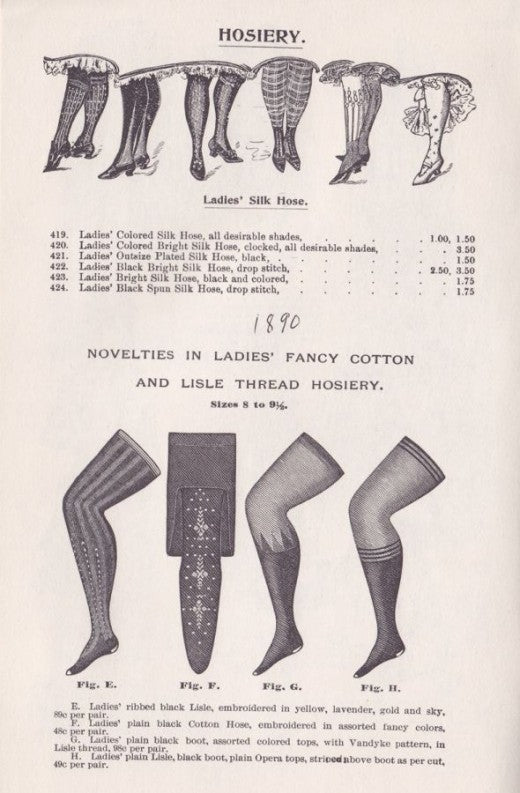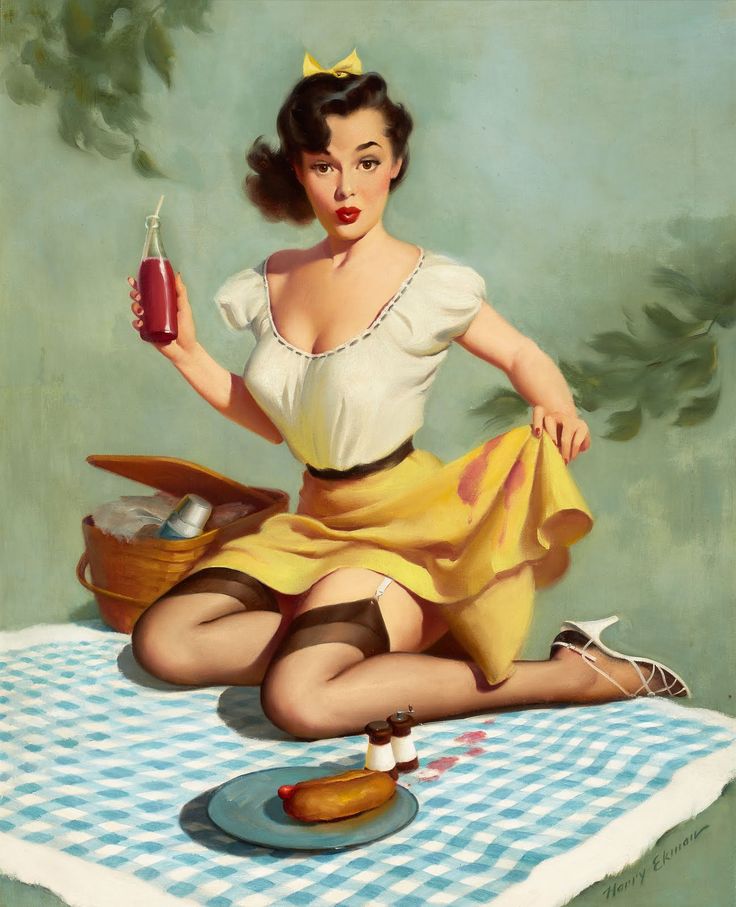History of Pantyhose, Tights, Stockings and Thigh Highs
Have you ever taken a look at your VienneMilano thigh highs and wondered how women could ever live without them? It is difficult to imagine, but the hold ups we know today are actually a fairly modern invention. The beginning of hosiery has a royally long history. Just as culture and popular fashion have evolved over the decades, so too has hosiery.
A Royal Beginning
Hosiery's first origins can be found in its name, a term deriving from the Anglo-Saxon (Old English) word "hosen" which means covering. Believe it or not, "hose" or "hosiery" were worn as early as the 15th and 16th centuries. At first, hose was worn almost exclusively by European noble men. This was for practical reasons of the era such as better mobility while riding horseback.
 King Charles IX of France wearing padded hosiery in 1566.
King Charles IX of France wearing padded hosiery in 1566.
Queen Elizabeth I was the first well known woman to have worn stockings and have it recorded. She received her first pair of knit silk stockings in 1560. The queen adored the softness and comfort of the luxury accessory and decided to wear silk stockings for the rest of her life. Since stockings of this time were made of materials such as silk and wool, they were not elastic or supportive and had to be kept up by garters or made fully-fashioned, meaning custom made.
Throughout the 18th and 19th centuries, while hosiery or legwear in some form was worn by women for modesty, warmth, and protection, dresses were kept long and stockings kept short. While there were some playful patterns in hosiery, the fashion of this time was still modest, and stockings were typically hidden under clothing.


1890 Harper's Bazaar catalog advertisement.
By the 1920's, hemlines were on the rise, and so too was the popularity of hosiery to cover exposed legs. The typical stocking of the roaring twenties would come up to just above the knee and be secured by a garter. Suspension belts, which had been invented in 1912, were an additional way to hold up stockings. While hosiery previously was meant to be hidden under dresses and skirts, flappers and women of the decade now flaunted their fishnet and embellished stockings. Hosiery was embraced as a statement of style and freedom.
 1920's women flaunting their thigh highs and garters.
1920's women flaunting their thigh highs and garters.
Flapper women showing off their fabulously styled stockings.
In 1939, DuPont, a company that uses science and engineering to solve pressing problems, invented nylon, revolutionizing the world of fashion and hosiery. Not only was nylon a cheaper material, its elasticity also made for a better fit for women of all shapes and sizes. Nylon stockings were all the craze and became an essential for every woman's wardrobe.
Politics and Pantyhose
By the late 1930's, political tensions between America and Japan were on the rise. 1937 brought a nationwide boycott of all Japanese products -- this included the ever so popular silk stocking. American women were now forced to turn away from silk hosiery and wear nylon instead.
World War II increased demand for nylon. Women were asked to ration and donate their hosiery for the war effort, as the material was used to create tools such as parachutes, airplane chords, and tents. The product was taken off the market completely and desperate women all over sought out creative alternatives. Women began to paint seams on the back of their legs or use self-tanners and "liquid stockings" to create the illusion that they were wearing hosiery.

Bottle of "Leg Silque", a commonly used liquid stocking product.

"No More Ladders" liquid stockings professionally painted-on.
 1943 Giggles Magazine advertisement for do-it-yourself Paint-on Stockings.
1943 Giggles Magazine advertisement for do-it-yourself Paint-on Stockings.
After the war, nylon stockings made their return and DuPont struggled to meet the product's demand. In 1945, the end of the war, Macy's sold out of their entire stock of 50,000 pairs of nylons in just 6 hours!

The 1945 post-war rush to purchase department store hosiery.
It's no secret that stockings were all the craze in the 1940's, but there was still one issue; they weren't self-supporting. Women continued to use garters and suspension belts to keep their hosiery in place. Yet with more revealing skirts and costumes appearing in pop culture, alternatives began popping up. During the 1940's and 1950's film producers would sometimes sew the hem of stockings into the briefs of actresses and stage performers. This concept helped spark the invention of pantyhose, a single sheer garment with two legs connected by a gusset and waistband. Pantyhose and tights were easier to mass produce and allowed women to wear even shorter hemlines. When pantyhose were first invented they were made of nylon, and all nylon hosiery was then referred to as "pantyhose." The term "pantyhose" now, however, refers to the hosiery style as opposed to the material.
Hosiery for the Glamorous

1967 Christian Dior ad emphasizing the weightlessness of Dior hosiery.
 Beautiful 1959 Lanvin Castillo stocking advertisement. Image Source: L'officiel magazine, n° 449-450, 1959
Beautiful 1959 Lanvin Castillo stocking advertisement. Image Source: L'officiel magazine, n° 449-450, 1959

Two examples of Harry Ekman's Pin-up girls wearing thigh high stockings.
Advertising in the 1950's and 60's romanticized the idea of hosiery and the women who wore it. Stockings were high end fashion accessories, worn by celebrities. Harry Ekman painted pin-up girls wearing stockings that led to glamorization of thigh highs. His portrayals made the everyday woman feel that she could be as glamorous a Broadway star when wearing her hold ups. Pop icon Twiggy furthered this idea as she popularized mini-skirts and dresses with stockings. Higher hemlines brought increasing popularity to tights and pantyhose as stockings were marginalized. Improvements in textile manufacturing added to the affordability of pantyhose. Furthermore, the 1960's brought more women into the working world meaning there was a higher demand for hosiery that could be worn both in and out of the office.

1960's pop icon Twiggy selling her own "Show Stopper" Panti-Tights.
Garters be Gone
In 1967, The British company "Pretty Polly" first used the term "hold-ups" on their self-supporting stockings. Their hold-ups were made with an elastic or silicone band and did not require garter belts to stay up. This idea was revolutionary. For centuries, a woman's only option was to wear pantyhose or struggle with the inconveniences of garters and suspender belts. With hold-ups or thigh highs, there was no unnecessary hassle of garter clips or ties. After Pretty Polly's product release, the word "hold-ups" became a generic trademark for this stocking style.

1968 Burlington Cameo advertisement. Image Source: Redbook magazine, November 1968, Vol. 132
Now that thigh highs were popularized, women could avoid the frustrating bumps that using garter belts created under a skirt or dress. Women could finally have it both ways: they could wear the stockings they loved and be free from garters! Thigh highs were further improved with the invention of Lycra in 1962. Lycra allows for increased durability giving stockings more resilience
When it comes to hosiery, today's options are limitless; we have certainly come a long way since the initial invention of thigh highs! While a number of brands specializing in hosiery have emerged since the 1960s, there are none quite like VienneMilano. Our use of premium materials procured and put together in Italy assures every customer an incredible experience. At VienneMilano, nylons, and garter belts are yesterday's story. Thigh highs can be worn to work or worn for play. Hosiery is no longer meant to draw attention away from the legs, but rather, complement them. Various colors, patterns, textures, and styles are available for women to flaunt with confidence. Perhaps this post has you dreaming of fashion from the roaring 20's? Well, why not bring retro back? Try one of our retro styles like ALBA back seam and embrace the bold!
Thigh highs are a fashion accessory which can make a statement whether it is simple or extravagant. It may have taken some time, but hosiery has landed in the present day with comfort, style, and expression all on our side. Who knows what history has in store for hosiery? Whatever it may be, alongside history, fashion is always evolving, and we can't wait to see what is in store.
History of Stockings Fashion Infographic
Our History of Hosiery Timeline provides a condensed history of the hose industry up until the creation of VienneMilano. We hope this helps you appreciate luxury hosiery as much as we do!







Comments
Paul Wright said:
Great article I love history of fashions. 5 star’s